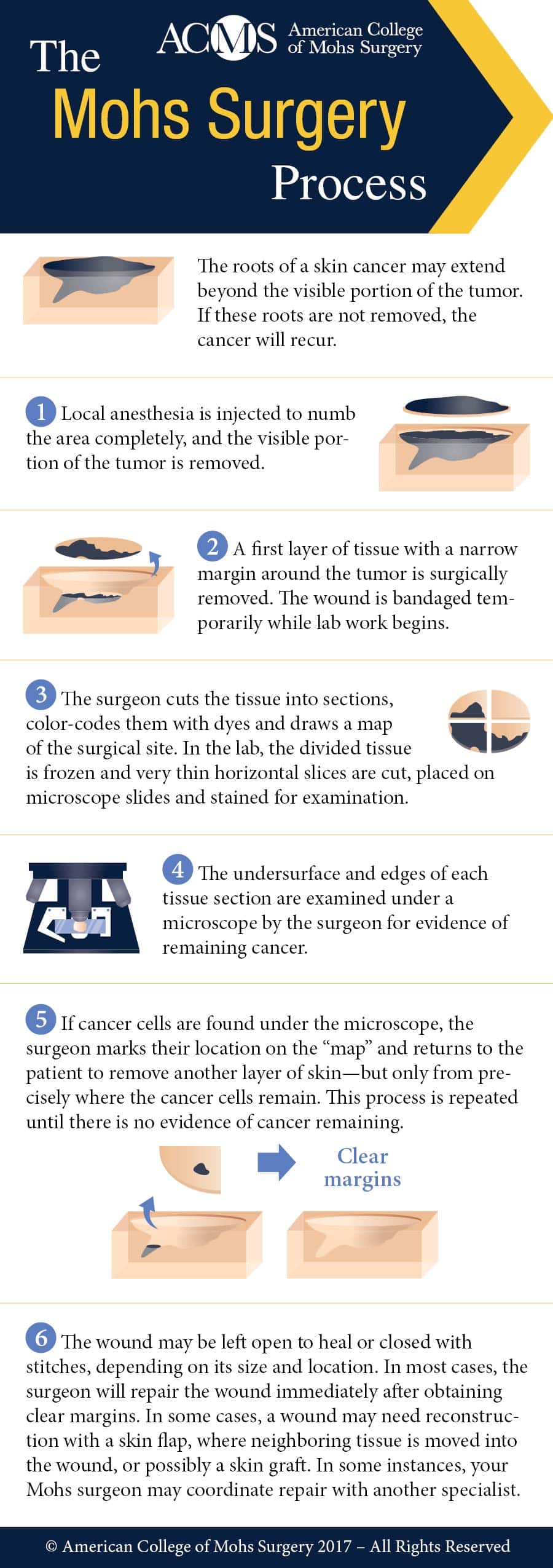Mohs micrographic surgery is an advanced treatment for skin cancer that offers the highest cure rate and leaves the smallest possible scar. It relies on the ability of the microscope to trace out and ensure removal of the skin cancer’s roots. During the procedure, your physician serves as the surgeon removing the skin cancer, pathologist and reconstructive surgeon. The basic principle behind the Mohs’ technique is to precisely identify and remove the entire skin cancer without taking any more normal skin than is absolutely necessary. Based on my experience after performing thousands of Mohs micrographic surgery cases, I feel comfortable recommending this treatment as the most exact and precise method for treating high risk skin cancers.Here is your brief guide to Mohs surgery: what it is and why it has become the treatment of choice for skin cancers located in cosmetically sensitive areas.
What is the history of Mohs surgery?
This procedure was developed by Frederick E. Mohs, MD, in the 1930s, hence the name “Mohs” micrographic surgery. It has been refined and perfected for more than half of a century.
How is Mohs micrographic surgery performed?
After injecting a local anesthetic, your Mohs surgeon will remove the skin cancer and a very thin layer of surrounding skin. The surgeon also creates a “map” or drawing of the removed tissue to be used as a guide to the precise location of any remaining cancer cells. Your surgeon will examine the removed tissue thoroughly to check for evidence of any remaining skin cancer cells. If there is any evidence of remaining caner under microscope, your surgeon will mark that on the “map” like a clock face. Then he/she will return to the specific area of residual tumor as indicated by the map and remove another thin layer of tissue only from the specific area where cancer cells were detected. The newly removed tissue will be examined under microscope using the same process. The process continues, layer-by-layer, until the cancer is completely removed.

What happens after the skin cancer is removed?
After your skin caner is completely removed, your Mohs surgeon will determine the best method of managing the wound resulting from the surgery. A small wound may be allowed to heal on its own. Larger wounds may be closed with sutures, a skin graft, or a flap. Your Mohs surgeon has undergone special training in reconstructive surgery of the skin and will individualize the treatment plan to give you best results and preserve functional capabilities while maximizing aesthetics.

Some skin cancers often do not respond well to common treatments, including those cancers that are large, those in difficult locations such as face, ears, scalp, neck, hands, feet and genitalia, and those complicated by prior treatment. Removing a recurrent skin cancer is more complicated because scar tissue may hide cancerous cells. In these cases, Mohs surgery is the most appropriate treatment.
How does Mohs micrographic surgery compare to other treatments for skin cancer?
Common treatment procedures such as curettage and electrodessication, cryosurgery, and radiation therapy often prove less effective because they destroy the tissue and leave no specimen for a pathology examination. Standard surgical excision examines only a fraction of the actual surgical margins for cause, whereas Mohs micrographic surgery evaluates 100% of the surgical margins.
Here are some benefits of Mohs micrographic surgery compared to other methods for treating skin cancer:
- Because it preserves the maximum amount of normal skin, Mohs micrographic surgery often results in smaller scars.
- Mohs micrographic surgery has the highest cure rate amongst all other treatments for skin cancer.
- Mohs micrographic surgery minimizes the risk of recurrence of cancer.
With the highest cure rate and smallest possible scar, Mohs surgery is the best treatment for skin cancers in high risk or cosmetically sensitive areas. If you are diagnosed with skin cancer, ask your dermatologist whether you could benefit from Mohs micrographic surgery.
To schedule a consultation, call 818-842-8000 or visit DermLA.com/schedule-an-appointment

